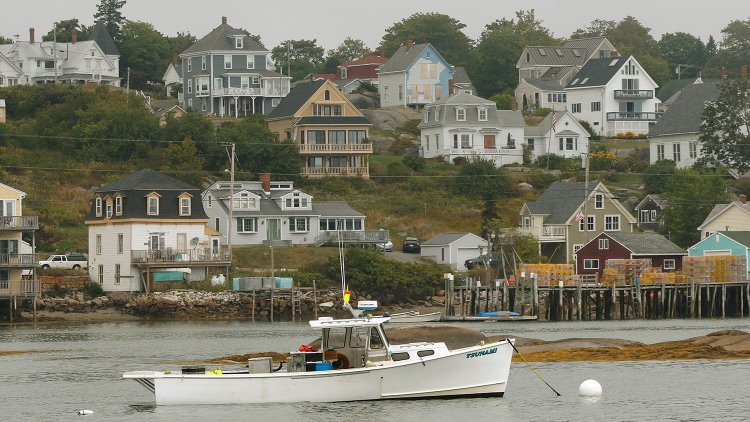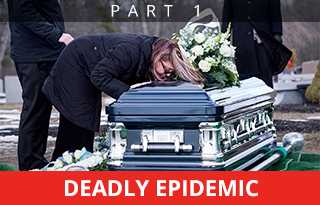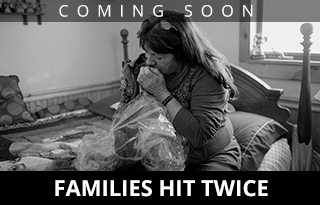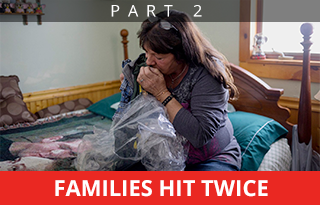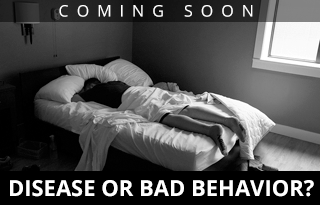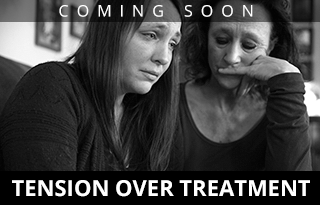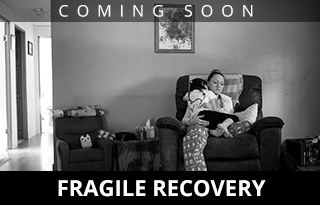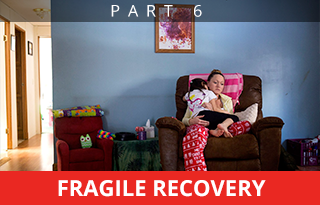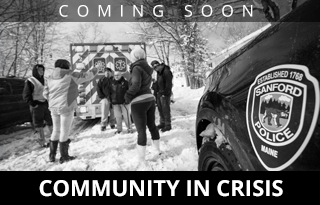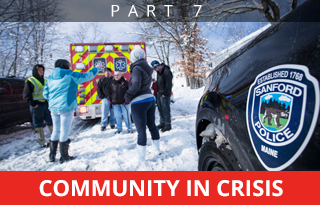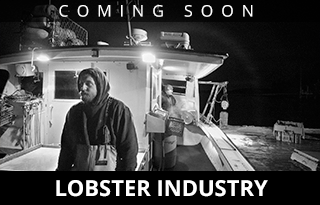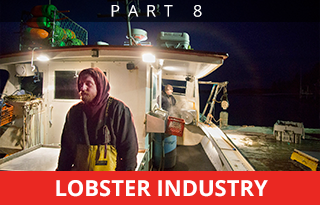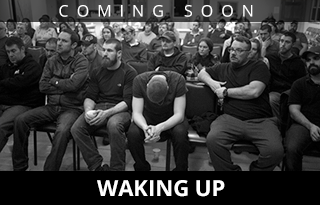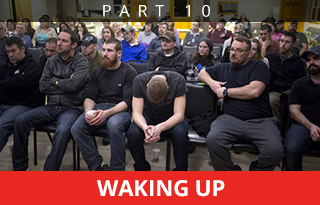Stonington is the nation’s lobster capital, landing more pounds than any other port in Maine and employing more lobstermen, too. Other towns may have more licensed lobster boat captains, but Stonington’s 181-boat fleet is filled with highliners – vessels that employ two sternmen, land more lobsters than most and often haul year-round in deeper offshore waters.
So as heroin has found its way into the Maine lobster fleet, it has found its way into this 1,300-person community, which generally leads the way in all things lobster. But Stonington does not like to talk about the drug problem. It has not had any public heroin funerals, like the ones held in some of the state’s other lobster ports, like Machias or Friendship. It has lost fishermen to drugs, but their obituaries simply read “died suddenly” or “taken too soon.”
A year ago, student lobsterman Elliott Nevells worked on a school project that called for random drug testing in the lobster fleet. His work, done as part of a young skipper’s program to cultivate future industry leaders, was warmly received at the Maine Fishermen’s Forum in Rockport, but his family urged him not to present it on the island for fear that it would hurt his fishing prospects.
“Stonington money comes from lobster,” said Nevells, a 17-year-old student at Deer Isle-Stonington High School who has his own license but still works as a sternman on another lobsterman’s boat. “People say I need to leave it alone. Why mess with a good thing? They say the system ain’t broke, don’t mess with it. But I say it is broken. They are hurting themselves, hurting others, hurting the industry.”
There is no data that reveals how many Maine lobstermen, or any other kind of worker, have died from using heroin or other opioids. That’s not how the state keeps track of drug overdoses, and it won’t release the identities of the 376 people who died from overdoses in Maine in 2016. That figure includes 313 deaths from opioids like heroin, prescription painkillers or fentanyl. But evidence that heroin has found its way into the industry that props up the Stonington economy pops up here and there.
The island ambulance began carrying Narcan, an antidote for opioid overdoses, five years ago. An ambulance official said at the time they might not even need it, but the EMTs have since “gotten good at using it,” a politician said. When an island lobster dealer came under fire for hiring Eastern European dock workers, he told critics that he couldn’t hire locals because he wanted drug-free workers. Locals are among those getting busted for bringing heroin, crack cocaine and other drugs to the island, and they are telling police they had planned to sell it in Stonington.
That’s not the only way the opioid epidemic is hurting the community. Some say it is starving port towns like Stonington that depend on lobster profits.
Economists estimate that every dollar paid to a lobsterman for his catch turns into three dollars on shore, paying for fishing expenses such as bait, fuel or new boats, or indirect purchases such as restaurant meals, new trucks or home additions. In a record year like 2016, that would mean the $533 million earned by Maine lobstermen would translate into a $1.6 billion economic trickle-down. In Stonington, where nearly one in five residents holds a lobster license, that would mean a $187 million cash infusion into the local economy stemming from record-setting lobster catches.
It can be difficult to track lobster profits. The average median household income in Stonington in 2014 was about $38,600, but lobstermen undoubtedly earn more. In 2015, the Stonington lobster fleet landed $62.2 million worth of lobsters, according to Waypoints, a new Island Institute demographic study. With 181 licensed lobstermen, that would mean the average Stonington boat made $343,600, before expenses like fuel, bait and boat payments and sternmen payouts.
But Rep. Walter Kumiega, a Stonington lawmaker who co-chairs the Legislature’s marine resources committee, says drug dealers are siphoning away the lobster profits and slowly starving lobster-dependent coastal communities of the economic benefit they should be enjoying during these lobster boom years. Landings and boat profits are at a record high this year, and the per-pound price remains over $4.
But lobstermen just aren’t spending like they usually do in good times, Kumiega said. And he should know – he is a carpenter whose business depends on lobstermen building new houses or fixing and expanding their old ones. Kumiega isn’t working on as many houses now, or last year, as he has during past boom years. Some lobstermen may be saving money for leaner times ahead, but others are definitely spending it on drugs, he said.
“The industry’s drug problem reaches beyond the boats and the docks, beyond the fishermen and their families, right into the heart of these fishing towns,” Kumiega said. “Lobster is more than what many of us do. It is what drives our whole economy. It pays for our schools. It pays for our roads, our services. It sustains our towns. Out here on the island, it keeps us all afloat.”
Some residents have formed the Opiate-Free Island Partnership to seek public funds for increasing drug education programming in the schools and to beef up local recovery programs, including the creation of a local Narcotics Anonymous group. The group’s bid for $20,000 failed in Stonington, but it passed in the town of Deer Isle during closely contested public votes in March.
Some opponents say the island has bigger drug problems to overcome, such as alcoholism. Others, like Selectman Donna Brewer, say the money wouldn’t make much of a difference. She told a crowd of about 75 people at Stonington’s annual town meeting that she has a drug problem in her family. Experts have told the family that an addict will either die or they will recover, she said. A little money won’t make a difference.
Charles Zelnick, a local doctor who prescribes Suboxone, a medication used to treat opioid dependency, worries that the group won’t get the funding it needs until it wins support from lobstermen. Its board mostly comprises newcomers, like himself and Todd West, the high school principal, and it doesn’t yet have representation from any members of the fishing community. Co-founder Charlie Osborn has asked, but so far, no fisherman has agreed to step up.
West said he would like to invite a fisherman who has struggled with addiction into the classrooms to talk about the dangers of heroin or pills. Many of the fishermen won’t do it, saying they want to distance themselves from the problem rather than become known for it on the island. A reputation can be hard to outrun on an island, West said.
And many of those who have kicked their drug habit have yet to beat their other demons, such as alcohol, he said.
But West and others, like Nevells, the student lobsterman, say ignoring the problem isn’t working. It’s only getting worse, not better, they say, and that’s bad for everyone.
“When you’re out there, you don’t know who around you is sober,” Nevells said. “Some out there stop halfway in the middle of their days to drive a needle in their arm. I don’t want to fish next to them. They don’t belong out on the water.
“It’s not safe. And it’s not fair because they cheat, they break rules put in place to protect the industry, to keep (the drug use) going. I have no doubt it’s ruining our industry.”
This story was updated at 4:09 p.m. April 13, 2017 after the Maine Attorney General’s Office revised its preliminary estimate of the number of drug overdose deaths in 2016.
Send questions/comments to the editors.

